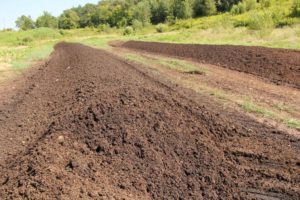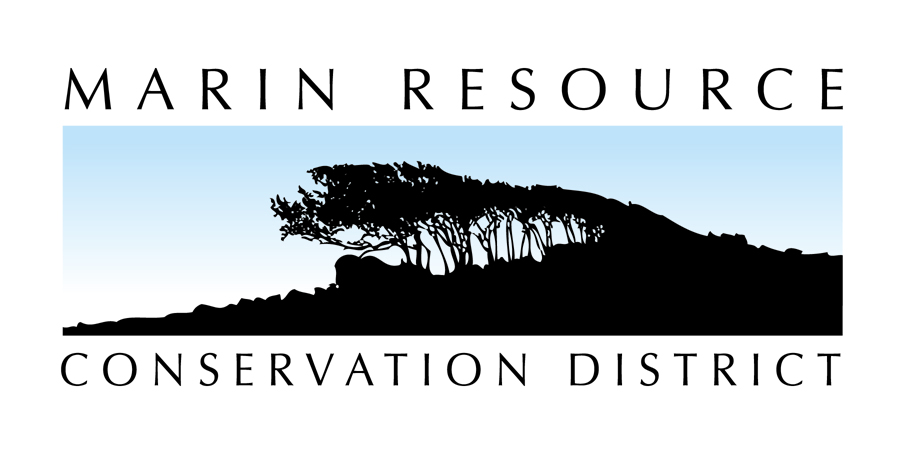Marin RCD's Carbon Farming Program
In our Carbon Farming Program, the Marin RCD provides farmers and ranchers with financial and technical assistance for the planning, design, and implementation of carbon beneficial practices.
What is Carbon Farming?
All plants naturally absorb and store atmospheric carbon as they grow through the process of photosynthesis. Some portion of this carbon migrates from the plant roots into the surrounding soil in other organic forms. Depending on how the plant and soil is managed (or not), the carbon can remain in the soil in a stable state—that is, become sequestered within the soil. The phrase ‘carbon farming’ means implementing farming practices that capture and hold carbon in vegetation and soils and/or reduce greenhouse gas emissions. Carbon farming includes small or large-scale practices – like implementing no-till cropping, prescribed grazing, agroforestry, or installing an anaerobic methane digester. Carbon Farming practices can also lead to improvements in soil health, water holding capacity, crop and forage productivity, water conservation, on-farm habitat, biodiversity, and climate resiliency.
Soil Organic Carbon
Carbon which is stored in soil is an incredibly important part of the wider carbon cycle which is a fundamental part of life on earth. ‘Soil organic carbon’ (SOC) – the amount of carbon stored in the soil – is a component of soil organic matter and is the basis of soil fertility. SOC releases nutrients for plant growth, promotes the structure, biological and physical health of soil, and is a buffer against harmful substances. A 1% increase in soil organic matter - a majority of which is carbon - will hold 20,000 gallons more water per acre!
What is Carbon Farm Planning?
Carbon Farm Planning combines traditional whole-farm planning and natural resource assessment with up-to-date climate science to identify practices that a land steward can implement to increase carbon sequestration and reduce greenhouse gas emissions on the farm. Marin RCD and our partners work with land stewards to create site-specific Carbon Farm Plans that prescribe applicable NRCS Conservation Practices. Climate benefits of implementing the proposed practices are then quantified using GHG planning and modeling tools including COMET Planner and COMET Farm.
Once completed, Carbon Farm Plans can serve as a foundation from which Marin RCD and our partners can work with a land steward to provide financial and technical assistance for the design and implementation phases. Carbon Farm Plans may also be living documents that are updated as land-bases change hands, a producer’s goals shift, or practices are implemented and new opportunities arise.
Carbon Farm Plan templates are available for rangelands, vineyards, orchards and forests on the carbon farming webpages of the North Bay RCDs, linked below:
Callout Box
CONTENT
Title (style: Heading 1)
Heading (style: Heading 2)
Subheading (style: Heading 3)
Special body text (style: Heading 4)
Body text (style: Paragraph)
Caption (style: Heading 5)
Link text (style: Heading 6)
Colors:
Menu Text: 31363b
Submenu text: 31363b
Title Text: 333c5a
Heading Text: 4c5a86
Subheading Text: 808cb3
Body Text: 26292b
Caption Text: 9aa132
Button Text: aebd26
Link Text: a3b201
Other Text: 506477
Symbol / Contrast color: dac900
Fields color: e3e5c7
Background color: eff1f5
Heading (style: Heading 2)
Description of section.

Practice
Description
Resources

Practice
Description
Resources

Practice
Description
Resources

Practice
Description
Resources

Practice
Description
Resources

Practice
Description
Resources
Text Module
Title (style: Heading 1)
Heading (style: Heading 2)
Subheading (style: Heading 3)
Special body text (style: Heading 4)
Body text (style: Paragraph)
Caption (style: Heading 5)
Link text (style: Heading 6)
Colors:
Menu Text: 31363b
Submenu text: 31363b
Title Text: 333c5a
Heading Text: 4c5a86
Subheading Text: 808cb3
Body Text: 26292b
Caption Text: 9aa132
Button Text: aebd26
Link Text: a3b201
Other Text: 506477
Symbol / Contrast color: dac900
Fields color: e3e5c7
Background color: eff1f5
Title of form
Text Module
Title (style: Heading 1)
Heading (style: Heading 2)
Subheading (style: Heading 3)
Special body text (style: Heading 4)
Body text (style: Paragraph)
Caption (style: Heading 5)
Link text (style: Heading 6)
Colors:
Menu Text: 31363b
Submenu text: 31363b
Title Text: 333c5a
Heading Text: 4c5a86
Subheading Text: 808cb3
Body Text: 26292b
Caption Text: 9aa132
Button Text: aebd26
Link Text: a3b201
Other Text: 506477
Symbol / Contrast color: dac900
Fields color: e3e5c7
Background color: eff1f5
